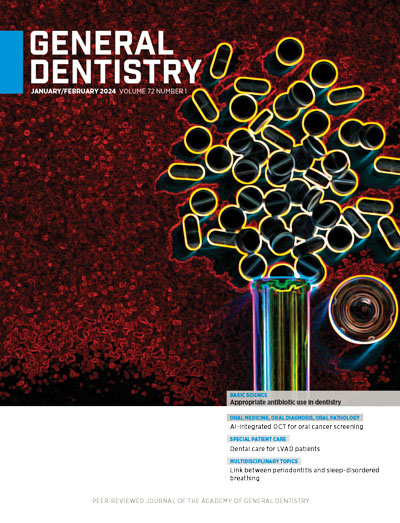-
SELF-INSTRUCTION
Multidisciplinary Topics
Unstable periodontal disease and its association with sleep-disordered breathing
Katherine C. Schacherl
Shengtong Han
John A. Schacherl
Andrew Dentino
This clinical study of 71 patients investigated the connection between unresolved periodontal disease and sleep-disordered breathing (SDB) using the Papillary Bleeding Index (PBI), Epworth Sleepiness Scale questionnaire, STOP-Bang questionnaire, and salivary cortisol testing. The results of this study suggested that the PBI is a reliable, objective means for general dentists to identify SDB in patients with unresolved periodontal disease.
2024 January/February; 72(1):16-25.
Full Article (PDF)
Self-Instruction Exercise No. GD521
-
Basic Science
Appropriate antibiotic use in dentistry: a review of the literature and clinical recommendations
Thomas M. Paumier
With recent increases in the rates of antimicrobial resistance and superbug infections, it is imperative for dentists to follow evidence-based guidelines when prescribing antibiotics to patients. This article reviews the latest evidence on when and when not to prescribe prophylactic antibiotics for specific clinical situations and discusses antibiotic guidelines for endodontic infection.
2024 January/February; 72(1):27-33.
Full Article (PDF)
-
Special Patient Care
The left ventricular assist device: a literature review and guidelines for dental care
Young Hwan Kim
Jennifer Pavone
Vivian A. B. Wasmuht-Perroud
Robert W. Frare
Paul R. Baker
In a review of the literature on dental care for patients with left ventricular assist devices, 3 articles met the inclusion criteria, and all reported that most dental care can be done in an outpatient setting after careful consideration of the patient’s condition and consultation with the medical team. The design of these devices, assessment of patients, and medical considerations are also discussed.
2024 January/February; 72(1):34-42.
Full Article (PDF)
-
Pediatric Dentistry
Diminutive compound odontoma in a child: a case report with emphasis on early detection
John K. Brooks
Haider Alshami
Rania H. Younis
Hokyoung Jang
Najwa Yousef
Hend Altajjar
Cindy Q. Zhou
Jeffery B. Price
The odontoma is regarded as a hamartomatous process of the jaws, most often discovered as an incidental radiographic finding. This case report describes the occurrence of a diminutive odontoma that was surgically removed before the onset of eruptive and pathologic consequences. Documented complications and syndromes associated with odontomas are also discussed.
2024 January/February; 72(1):43-45.
Full Article (PDF)
-
SELF-INSTRUCTION
Oral Medicine, Oral Diagnosis, Oral Pathology
Artificial intelligence–integrated optical coherence tomography for screening and early detection of oral cancer
Ravleen Nagi
Ajay Bibra
N. Rakesh
Deepa Jatti Patil
Tarun Vyas
This article reviews the scope and applications of optical coherence tomography (OCT) for the detection of precancerous oral lesions, in particular when combined with artificial intelligence (AI) to assist in achieving high-accuracy interpretation of OCT images. Due to its objectivity, reliability, and ability to perform computations on large amounts of data, AI offers promise for future integration into OCT screening for early-stage oral cancer.
2024 January/February; 72(1):46-52.
Full Article (PDF)
Self-Instruction Exercise No. GD522
-
Oral Medicine, Oral Diagnosis, Oral Pathology
Herpes zoster: treatment, management, and prevention with the recombinant DNA vaccine
Emily Li
James J. Closmann
Richard C. Jordan
Herpes zoster is a reactivation of dormant varicella-zoster virus that most often erupts as painful vesicles in a unilateral dermatomal distribution. A recombinant DNA vaccine has been found to be safe and effective in older adults and immunocompromised individuals. This report discusses herpes zoster, postherpetic neuralgia, their treatment, and prevention with vaccines.
2024 January/February; 72(1):54-57.
Full Article (PDF)
-
SELF-INSTRUCTION
Orthodontics
Patients’ perception of orthodontic mini implants at different sites: anterior vs posterior maxilla
A. Sumathi Felicita
This study compared patient experiences of mini implant treatment in the anterior vs posterior maxilla. The anterior group experienced less discomfort and had a better overall experience, most notably immediately after implant placement.
2024 January/February; 72(1):58-64.
Full Article (PDF)
Self-Instruction Exercise No. GD523
-
Oral Medicine, Oral Diagnosis, Oral Pathology
Debilitating lower back pain during menses unexpectedly resolved after treatment of subclinical temporomandibular disorder: a case report
Christina Chan
Laura Chan
Enoch T. Ng
This case report describes a patient in whom debilitating lower back pain during menses resolved when she received treatment for subclinical temporomandibular disorder. The authors explain that this outcome could have been the result of neurologic, postural, inflammatory, or qi flow changes attributed to the patient’s orthotic treatment.
2024 January/February; 72(1):66-70.
Full Article (PDF)
-
Pediatric Dentistry
The effect of pediatric drugs on color stability of bulk-fill and conventional composite resins
Somayeh Hekmatfar
Zhila Fahim
Mahsa Davan
Karim Jafari
In an in vitro study, all tested composite resins displayed clinically perceptible color changes after immersion in liquid medications commonly used by children. The color change was significantly greater in bulk-fill than conventional composite resin and greater in 4-mm-thick than 2-mm-thick specimens. However, there was no significant difference in color change based on the immersion drug for either type of composite.
2024 January/February; 72(1):72-77.
Full Article (PDF)

